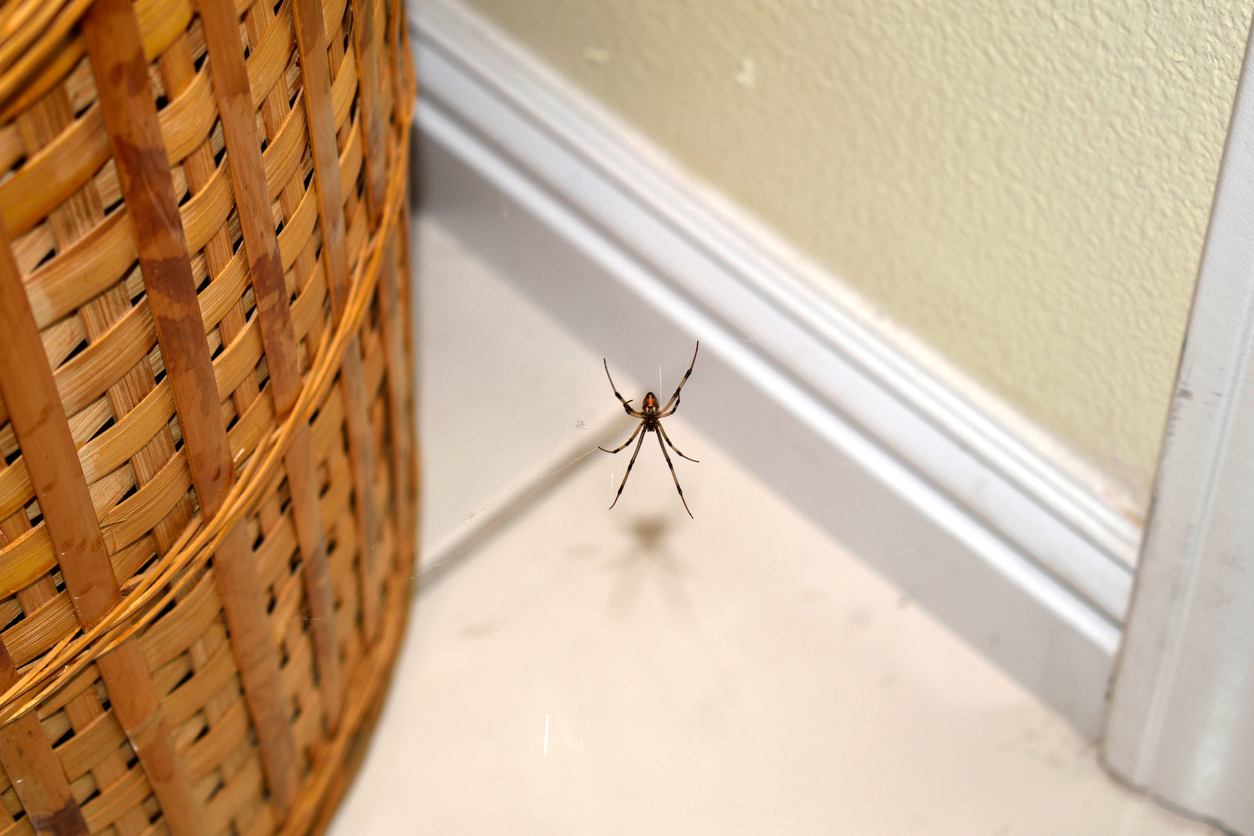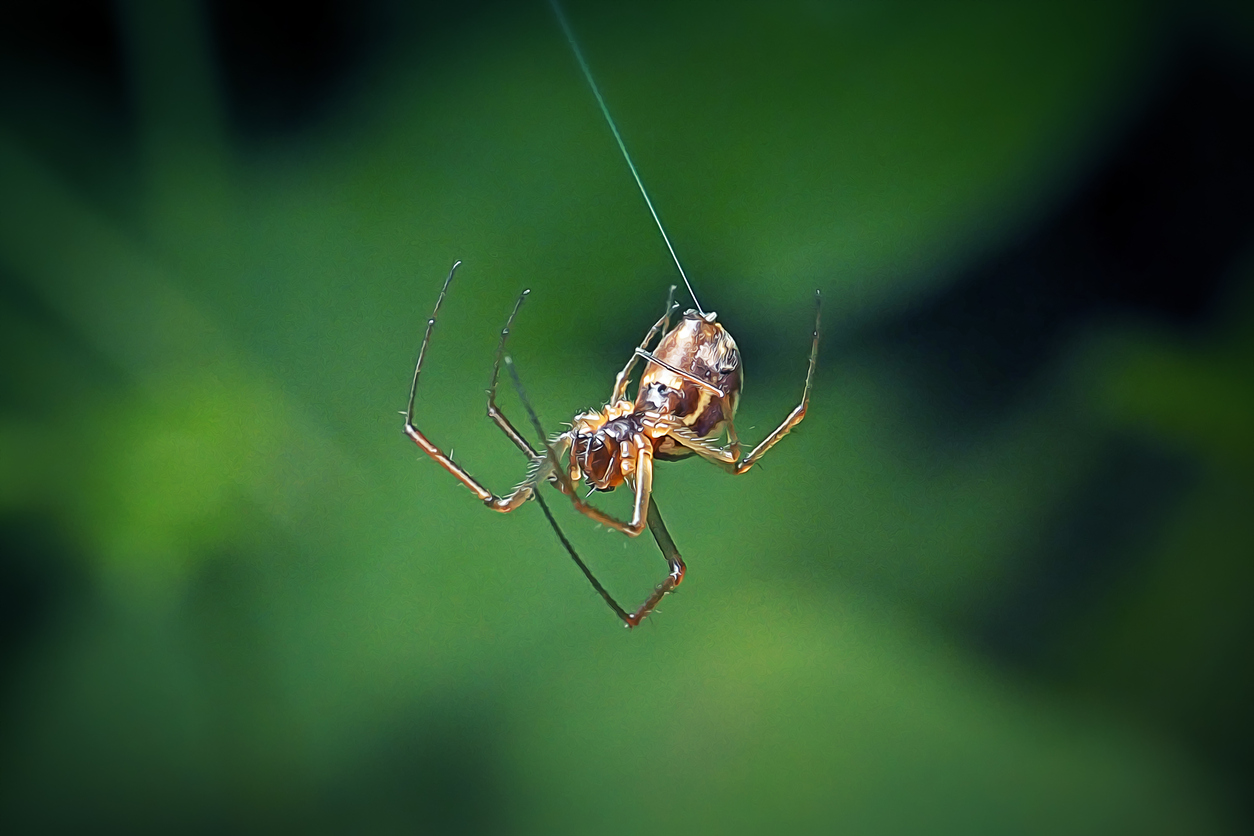Spiders
Common Pest: Spiders
All spiders are venomous. However, not all spider venom is toxic to humans. A favorite spider of children, the “Daddy Long Legs” (not a true spider because, it only has only two eyes, a segmented abdomen and does not produce silk) is completely harmless to humans, while its venom is approximately 120 times more potent to its prey than any other spider in North America. Spiders are not insects, they are arachnids. They can live almost everywhere – on the ground, under rocks, leaves and brush, around playground equipment, in attics, basements, crawl spaces, window wells, landscape areas, on plants, in grass, on trees, in underground caves, and on water. Except they don’t live in Antarctica!
Spiders have two body parts – a cephalothorax (head) and abdomen, eight legs, six to eight eyes (arranged in pairs) and piercing/sucking mouthparts. What distinguishes spiders from other arachnids is an appendage at the base of the abdomen, called a spinneret, which is used for silk-making purposes. Pound for pound, spider silk is stronger than steel. Silk is used for housing, catching prey, reproduction and defense.
Various species of spiders
(like many insects) were thought to have been introduced to the U.S. by way of cargo ships from Europe, not as adult stowaways but rather as egg sacs in wooden crates. There are approximately 35,000 to 40,000 species of spiders worldwide. Spiders range in size from microscopic to some species of tarantulas the size of a dinner plate. Spiders are an integral part of the ecosystem and have voracious appetites. On average, an adult male spider can maintain an unwanted insect population in an area equal to about one square acre of land. Species commonly found in our area are the yellow sac, wolf, funnel web (not the highly toxic specie found in Australia), orb weavers (which spin magnificent webs), brown recluse, black widow, tarantula (inhabiting primarily the central and southern part of the state) cellar, and jumping spiders.
Various species of spiders
(like many insects) were thought to have been introduced to the U.S. by way of cargo ships from Europe, not as adult stowaways but rather as egg sacs in wooden crates. There are approximately 35,000 to 40,000 species of spiders worldwide. Spiders range in size from microscopic to some species of tarantulas the size of a dinner plate. Spiders are an integral part of the ecosystem and have voracious appetites. On average, an adult male spider can maintain an unwanted insect population in an area equal to about one square acre of land. Species commonly found in our area are the yellow sac, wolf, funnel web (not the highly toxic specie found in Australia), orb weavers (which spin magnificent webs), brown recluse, black widow, tarantula (inhabiting primarily the central and southern part of the state) cellar, and jumping spiders.
Spiders rarely live longer than a year or two
Spiderlings emerge in the springtime from egg sacs laid the previous fall. Some adult females carry the entire nursery on their backs. Depending on the specie, eggs can hatch as quickly as a couple of weeks or as slowly as a year. Newly hatched spiders are capable of wind blown dispersion called “ballooning.” They climb to an exposed perch, spin out long strands of silk and cast them like a parachute designed to make use of wind currents that carry them miles in any direction. They nest where they land. This is how spiders end up on rooftops or in attics. Much of the success of spiders can be directly attributed to their extensive use of silk and poison.
Spiders are categorized into two broad groups based on the way they hunt and capture food. Some prefer the use of silk by spinning intricate webs designed to passively capture unsuspecting prey or, by gathering up silk and using their hind legs to cast a net to trap an insect. Others use no silk at all, preferring to actively hunt their quarry, much like a lioness would stalk and hunt her prey. Spiders prefer a steady diet of arthropods like grasshoppers, flies, moths, worms, caterpillars, crickets, other insects and sometimes, each other. This highly evolved killing machine comes equipped with a formidable set of fang-tipped jaws, which are inserted into their victims much like a doctor using a hypodermic needle to administer an injection to a patient. In the spider kingdom “big” is a relative term. Jumping spiders are one such example. This spider can leap over twenty times its size to land on and devour its prey. The green jumping spider is often considered the supermodel of the spider world. If you’re an insect and decide to tangle with this beauty, rest assured, the outcome won’t be pretty. Once bitten, venom will immobilize a victim in a matter of seconds, while digestive enzymes liquefy internal tissue. A spider uses its piercing/sucking mouthparts to withdraw the material. The feeding process is similar to drinking a caterpillar smoothie through a straw. All that remains is the hollow skeletal structure of the insect.
Most spider venom is not toxic to humans
A bite may cause discoloration or swelling. Spiders are capable of inflicting a painful bite, however rarely do so unless provoked. Spiders generally make a hasty retreat upon human approach. Avoid being bitten by following some simple guidelines.
How to Avoid Spider Bites
- Keep cellar rooms, closets, attics and basements as clutter free as possible.
- Take care while performing routine chores such as gardening, reaching in a window well, wood pile or in seldom used drawers and cabinets.
- Inspect and clean all camping gear after each use.
- Shake out shoes, jackets and hats before wearing.
Most spider venom is not toxic to humans
A bite may cause discoloration or swelling. Spiders are capable of inflicting a painful bite, however rarely do so unless provoked. Spiders generally make a hasty retreat upon human approach. Avoid being bitten by following some simple guidelines.
How to Avoid Spider Bites
- Keep cellar rooms, closets, attics and basements as clutter free as possible.
- Take care while performing routine chores such as gardening, reaching in a window well, wood pile or in seldom used drawers and cabinets.
- Inspect and clean all camping gear after each use.
- Shake out shoes, jackets and hats before wearing.
If you have a continual or chronic spider problem in your home or business, let the experts at Bugs By Brian treat your home or office to better protect the health and safety of all occupants. We will determine the scope of the spider infestation by performing a thorough inspection at the time of treatment and identify any species found. We make suggestions to eliminate conditions conducive to spider entry. We discuss landscape management, structural deficiencies and use formulations designed for long-term control of invasive spiders.

St. Louis, Missouri
Email: scheduling@bugsbybrian.com
Call: (636) 394-0101
Location: 1401 Marsh Ave., Ellisville MO 63011
Melbourne, Florida
Email: scheduling@bugsbybrian.com
Call: (321) 674-1665
Location: 3830 S. Highway A1A Suite, 4135 Melbourne Beach, FL 32951
Ready to get started?
We offer free, no obligation estimates for all our pest control services.
Follow us on our social media plateforms


